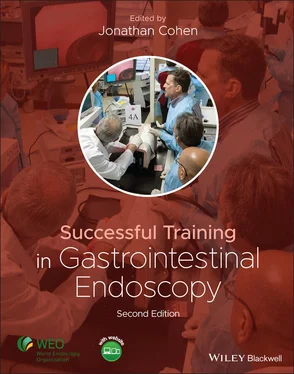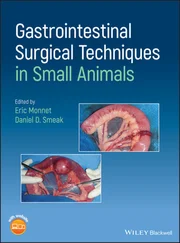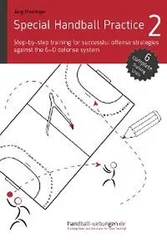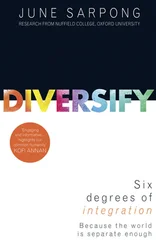Successful Training in Gastrointestinal Endoscopy
Здесь есть возможность читать онлайн «Successful Training in Gastrointestinal Endoscopy» — ознакомительный отрывок электронной книги совершенно бесплатно, а после прочтения отрывка купить полную версию. В некоторых случаях можно слушать аудио, скачать через торрент в формате fb2 и присутствует краткое содержание. Жанр: unrecognised, на английском языке. Описание произведения, (предисловие) а так же отзывы посетителей доступны на портале библиотеки ЛибКат.
- Название:Successful Training in Gastrointestinal Endoscopy
- Автор:
- Жанр:
- Год:неизвестен
- ISBN:нет данных
- Рейтинг книги:3 / 5. Голосов: 1
-
Избранное:Добавить в избранное
- Отзывы:
-
Ваша оценка:
- 60
- 1
- 2
- 3
- 4
- 5
Successful Training in Gastrointestinal Endoscopy: краткое содержание, описание и аннотация
Предлагаем к чтению аннотацию, описание, краткое содержание или предисловие (зависит от того, что написал сам автор книги «Successful Training in Gastrointestinal Endoscopy»). Если вы не нашли необходимую информацию о книге — напишите в комментариях, мы постараемся отыскать её.
Teaches trainee gastroenterologists the endoscopic skills needed to meet the medical training requirements to practice gastroenterology and helps clinical specialists refresh their skills to pass their recertification Successful Training in Gastrointestinal Endoscopy, Second Edition
Successful Training in Gastrointestinal Endoscopy, Second Edition
Successful Training in Gastrointestinal Endoscopy — читать онлайн ознакомительный отрывок
Ниже представлен текст книги, разбитый по страницам. Система сохранения места последней прочитанной страницы, позволяет с удобством читать онлайн бесплатно книгу «Successful Training in Gastrointestinal Endoscopy», без необходимости каждый раз заново искать на чём Вы остановились. Поставьте закладку, и сможете в любой момент перейти на страницу, на которой закончили чтение.
Интервал:
Закладка:
The final focus of this chapter will be on methods to assess the mastery of these required skills by trainees. Accrediting bodies have placed a growing emphasis on assessment and documentation of competency, yet few programs do any type of formal evaluation other than a global subjective assessment of skills toward the end of training. This type of informal global assessment is fraught with biases inherent to subjective assessments. It also fails to identify struggling trainees early enough to provide timely remediation. Instead, assessment must be an ongoing process from the first scope performed during fellowship to the last. In general, there are four different types of assessment: written tests, performance tests, clinical observation methods, and a group of miscellaneous tests made up of oral examinations, portfolios, and the like [25]. Each can be used in a formative (testing primarily for the purposes of feedback or learning) or summative (testing for grading purposes) manner, yet as we will discuss, a specific testing method may be better suited for assessment of a particular skill. This chapter will address the best methods to provide continuous assessment of trainees' cognitive and motor skills ( Table 6.2).
Table 6.2 How skills can be taught and assessed?
| Teaching methods | Assessment methods | |
|---|---|---|
| Early skills (first 50 procedures) | ||
| Cognitive | Self‐directed learningTextsArticlesMultimedia aidsLectures | Written examsBoard‐type questionsFormative assessment during didacticsSimulationSedation/airway/complication management |
| Motor | Patient‐based trainingSimulation trainingComputer simulator Ex vivo course | Early formative assessmentObjective structured clinical examinations (OSCE) |
| Intermediate skills (50–250 procedures) | ||
| Cognitive A. Pathology recognition | Self‐directed learningTextPhoto AtlasMultimedia | Written examsPathology recognition |
| B. Decision‐making | Patient‐based trainingSocratic methodSelf‐directed learningMultimedia (GESAP) | Patient‐based trainingSocratic methodWritten examsBoard‐type questionsOngoing assessmentStandardized assessment tool |
| Motor | Patient‐based trainingSimulation Ex vivo modelsScope locating deviceScopeGuide | Ontinuous assessment toolOSCEBovine model |
Early cognitive skills
Before hands‐on endoscopy training begins, trainees need to undergo a curriculum that ensures the early cognitive skills (anatomy, preparation, scope selection, sedation, and indications/contraindications) have been acquired. Like many other aspects of endoscopy, training has been traditionally accomplished at the bedside under direct supervision. Cognitive skills however have been learned entirely “on‐the‐job.” In fact, it is likely of greatest benefit to us and our patients to have the bulk of these cognitive skills learned prior to introduction to the endoscopy suite. This will save valuable teaching time and make the teaching experience more meaningful for the trainee and teacher alike. For all of the specific early cognitive skills outlined, each can be generally be achieved through multiple instructional media, including endoscopic atlases, textbooks, and pertinent journal articles such as professional society practice guidelines. Common to all is that these methods are primarily “self‐directed” learning tools. The trainee only needs ready access and guidance as to what materials are most pertinent to ensure all cognitive skills are covered and that the materials are of appropriate quality. This is best accomplished by assigning trainees a curriculum of required material that cover intended topics and learning goals. The rest is done as self‐study. Didactic lectures can also be included to augment these learning materials. Ideally, training programs should have new fellows undergo a series of “Core Endoscopy Lectures” during the first 2 months of fellowship in addition to their required self‐directed learning materials. Each lecture to focus on one of the core cognitive competencies. Lectures or discussion groups can ensure that students have the opportunity to ask questions and clarify misunderstandings that may arise from their self‐directed learning. When trainees participate in interactive sessions, these didactic discussions can also allow for formative assessments of the trainees' fund of knowledge.
Assessment is the other important half of any educational endeavor but is the one often neglected. For cognitive skills in general, the use of brief written exams can be an easy means to reliably and objectively measure the acquisition of these skills. As with any assessment, these can be used as self‐assessment exams for feedback (formative assessment) or as higher‐stakes exams that must be passed prior to advancing to patient‐based practice (summative assessment). Regardless how an institution uses the assessment, it should be carried out to ensure the learning goals of a curriculum are being met. Both education and assessment goals can be met through the use of computer multimedia tools where self‐assessment quizzes can be linked directly to the learning material and provide real‐time feedback on areas where the trainee may have answered incorrectly.
Sedation skills are unique in that simulation training can also be effectively employed to augment the other self‐directed learning tools. Much of sedation training involves airway management taught to all medical students in basic and advanced life support courses. Even as fellows, these skills should be renewed periodically based on American Heart Association recommendations and endoscopy training programs should ensure that these skills or equivalent training is up to date. The use of airway and anesthesia mannequins can help teach the skills of basic airway management, monitoring, titration of medications, and management of sedation complications such as the appropriate use of reversal agents. These simulation tools can also be used for skills assessment where trainees must be able to demonstrate adequate ability in the management of these various sedation skills. Which specific modalities an institution uses for early cognitive training will depend largely on the resources available. Whichever are used, however, a concerted effort should be made to ensure these basic skills are taught prior to initiating patient‐based training, and some form of assessment (even if informal formative feedback) is used and documented as part of the fellows training folder.
Early motor skills
The basic skills of holding the scope correctly and orientation to the various dials and buttons are simple first steps. This initial orientation to the scopes mechanics is brief and takes only 10–15 minutes. Frequently, this is done just prior to the first patient‐based colonoscopy but can be accomplished outside the endoscopy suite, with a basic scope. A computer simulator, static mechanical model, or an ex vivo animal model setup can also provide the same basic exposure but can quickly be followed by the next step of learning how to insert and advance the scope through a lumen. Any one of these simulator environments affords the trainee the liberty to experiment with the early motor skills (controls, insufflations, scope advancement, and mucosal inspection) in a safe environment away from patients and in a low stress environment without concerns for patient pain, procedure completion issues, or the usual time constraints. Research has shown that the use of computer simulators during initial training of novice endoscopists can indeed teach basic scope steering, lumen identification, and scope advancement as well, if not better than traditional patient‐based training [23, 26, 27] ( Figure 6.31). In this research, GI fellows who had received computer simulation training over a 6‐hour curriculum (20–25 simulated cases) outperformed traditionally trained fellows over the first 20–30 patient‐based cases. These fellows were nearly twice as likely to reach the cecum independently and did so with greater speed, better lumen visualization, and most importantly with greater patient comfort than traditionally trained fellows. This performance advantage was observed for roughly 30 patient‐based procedures, after which the skills for the traditionally trained group statistically caught up. On the basis of these positive results and others like it, some institutions, such as the Mayo Clinic, have adopted early training curricula around computer simulation, requiring all GI fellows to perform roughly 20–30 simulated colonoscopies prior to being allowed to begin patient‐based training. Could longer simulation training provide an even greater performance advantage seen in the simulator‐trained group? This is possible, as similar research to the study above has shown 10 hours of simulator training, imparting a measurable sbenefit in skills in up to 80 live cases [21]. However, other data examining the learning curves of performance metrics during simulation training have found that a trainee's performance on the simulator tends to plateau after roughly 20–25 cases, suggesting that a computer simulator has taught a trainee all it can during this length of training [28, 29]. This is likely due to the modest level of difficulty of the cases currently available on computer simulators [30, 31]. As the realism of looping, haptic feedback, and case complexity improves on these models, the benefits computer simulation training could conceivably extend well beyond the initial training of novices. Currently, however, it is recommended that computer simulation be used primarily for teaching early motor skills [22]. Simulators are also still prohibitively expensive ($75K–100K), and as a result are found primarily at larger academic teaching institutions. One solution that would allow for smaller training programs to reap the benefits of these teaching tools would be the development of regional training centers. This initial simulation training of 20–25 cases could easily be completed over a weekend course and sponsoring such courses could provide a return on an investment for institutions that have already purchased such devices. Regional training centers could also serve as testing centers. As computer simulators become more advanced, it is inevitable that they will become part of board certification in gastroenterology, where testing of competence in endoscopy skills will be eventually be required. Before this type of high‐stakes assessment could happen though, the complexity and measurable performance metrics of current endoscopy simulators would need to be greatly enhanced and separately validated for such testing purposes.
Читать дальшеИнтервал:
Закладка:
Похожие книги на «Successful Training in Gastrointestinal Endoscopy»
Представляем Вашему вниманию похожие книги на «Successful Training in Gastrointestinal Endoscopy» списком для выбора. Мы отобрали схожую по названию и смыслу литературу в надежде предоставить читателям больше вариантов отыскать новые, интересные, ещё непрочитанные произведения.
Обсуждение, отзывы о книге «Successful Training in Gastrointestinal Endoscopy» и просто собственные мнения читателей. Оставьте ваши комментарии, напишите, что Вы думаете о произведении, его смысле или главных героях. Укажите что конкретно понравилось, а что нет, и почему Вы так считаете.












